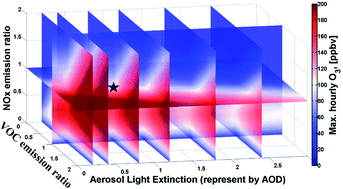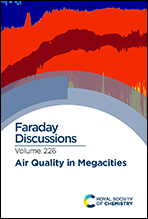Avoiding high ozone pollution in Delhi, India†
Abstract
Surface ozone is a major pollutant threatening public health, agricultural production and natural ecosystems. While measures to improve air quality in megacities such as Delhi are typically aimed at reducing levels of particulate matter (PM), ozone could become a greater threat if these measures focus on PM alone, as some air pollution mitigation steps can actually lead to an increase in surface ozone. A better understanding of the factors controlling ozone production in Delhi and the impact that PM mitigation measures have on ozone is therefore critical for improving air quality. Here, we combine in situ observations and model analysis to investigate the impact of PM reduction on the non-linear relationship between volatile organic compounds (VOC), nitrogen oxides (NOx) and ozone. In situ measurements of NOx, VOC, and ozone were conducted in Delhi during the APHH-India programme in summer (June) and winter (November) 2018. We observed hourly averaged ozone concentrations in the city of up to 100 ppbv in both seasons. We performed sensitivity simulations with a chemical box model to explore the impacts of PM on the non-linear VOC–NOx–ozone relationship in each season through its effect on aerosol optical depth (AOD). We find that ozone production is limited by VOC in both seasons, and is particularly sensitive to solar radiation in winter. Reducing NOx alone increases ozone, such that a 50% reduction in NOx emissions leads to 10–50% increase in surface ozone. In contrast, reducing VOC emissions can reduce ozone efficiently, such that a 50% reduction in VOC emissions leads to ∼60% reduction in ozone. Reducing PM alone also increases ozone, especially in winter, by reducing its dimming effects on photolysis, such that a 50% reduction in AOD can increase ozone by 25% and it also enhances VOC-limitation. Our results highlight the importance of reducing VOC emissions alongside PM to limit ozone pollution, as well as benefitting control of PM pollution through reducing secondary organic aerosol. This will greatly benefit the health of citizens and the local ecosystem in Delhi, and could have broader application for other megacities characterized by severe PM pollution and VOC-limited ozone production.

- This article is part of the themed collection: Air quality in megacities


 Please wait while we load your content...
Please wait while we load your content...